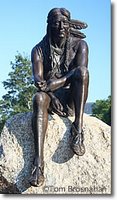"Iyanough, a man not exceeding twenty-six years of age, but very personable, gentle, courteous, and fair conditioned, indeed not like a savage, save for his attire. His entertainment was answerable to his parts, and his cheer plentiful and various."
This weekend, members of The Washington Junto will venture to Cape Cod for Independence Day festivities. In addition to the beer, the hamburgers, the beer, sunshine, scotch, pina coladas, sailing, beaching, beer and beer, The Washington Junto will also visit the grave of Sachem Iyannough.
His gravestone reads:
Sachem Iyannough 1621
On This Spot Was Buried
The Sachem Iyannough
The Friend And Entertainer Of The Pilgrims
July 1621
Below is some more information about the Sachem. He is also mentioned in Nathaniel Philbrick's new book "Mayflower".
Iyannough (also spelled Iyanough) was a Native American sachem (chief) of the Mattachiest (Mattakeese) tribe of Cummaquid in the area of what is now Cape Cod, Massachusetts. Historic records mention the assistance and "entertainment" offered by Hyannis towards the pilgrims and later colonists. The Hyannis village in Cape Cod was named after him.
A statue of Iyannough can be found today in the front of the village greens in down town Hyannis. Another monument to Iyannough is his gravesite, just north of Massachusetts route 6A in the village of Cummaquid, MA. A sign along Route 6A marks the spot.
He is known to have died in 1621, when he was in his mid-twenties. Reason for death appear to be disease and exposure to cold during a chase. The grave was discovered in 1961 by a farmer plowing his field.
In 1620, the Pilgrims actually skirted Barnstable on their journey to Plymouth, but decided not to enter the harbor due to a snowstorm. In 1621, a young Pilgrim by the name of John Billington wandered back into the forests of "Mattacheese," lost his way, and was eventually rescued by a band of Pilgrims aided by the Sachem Iyannough

1 comment:
CORRECTION: In performing a Google search on Sachem, I learnt that it was actually 1860 that the farmer found the grave whilst plowing.
Post a Comment